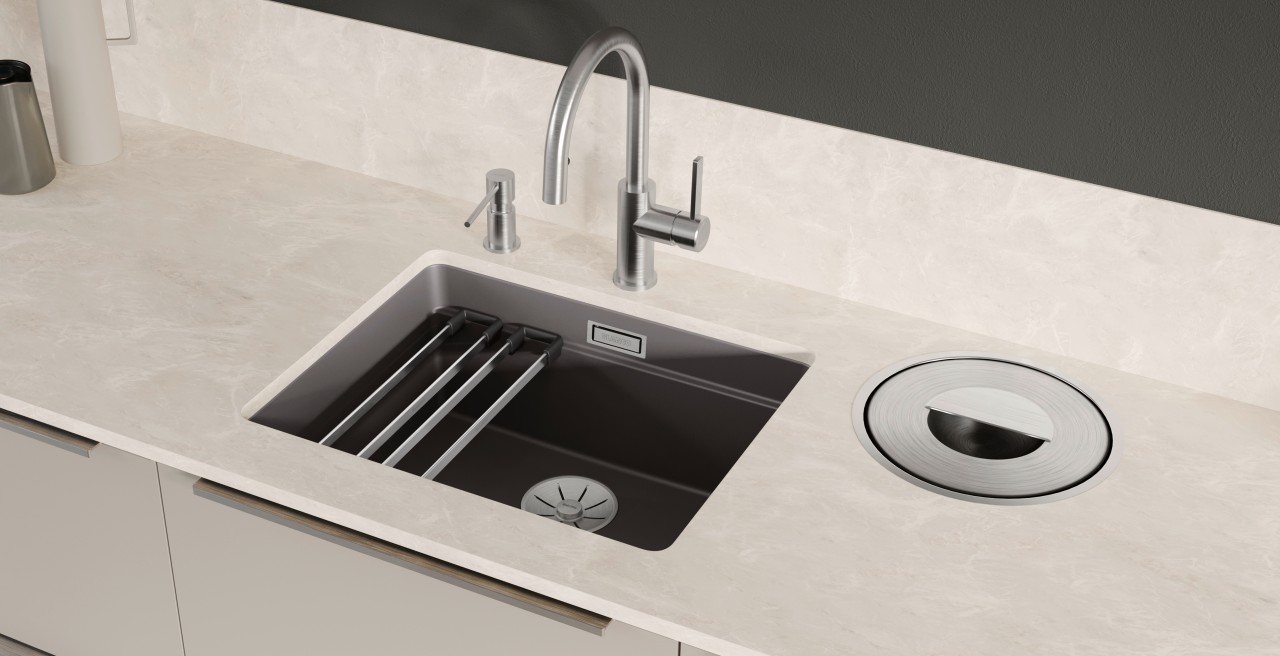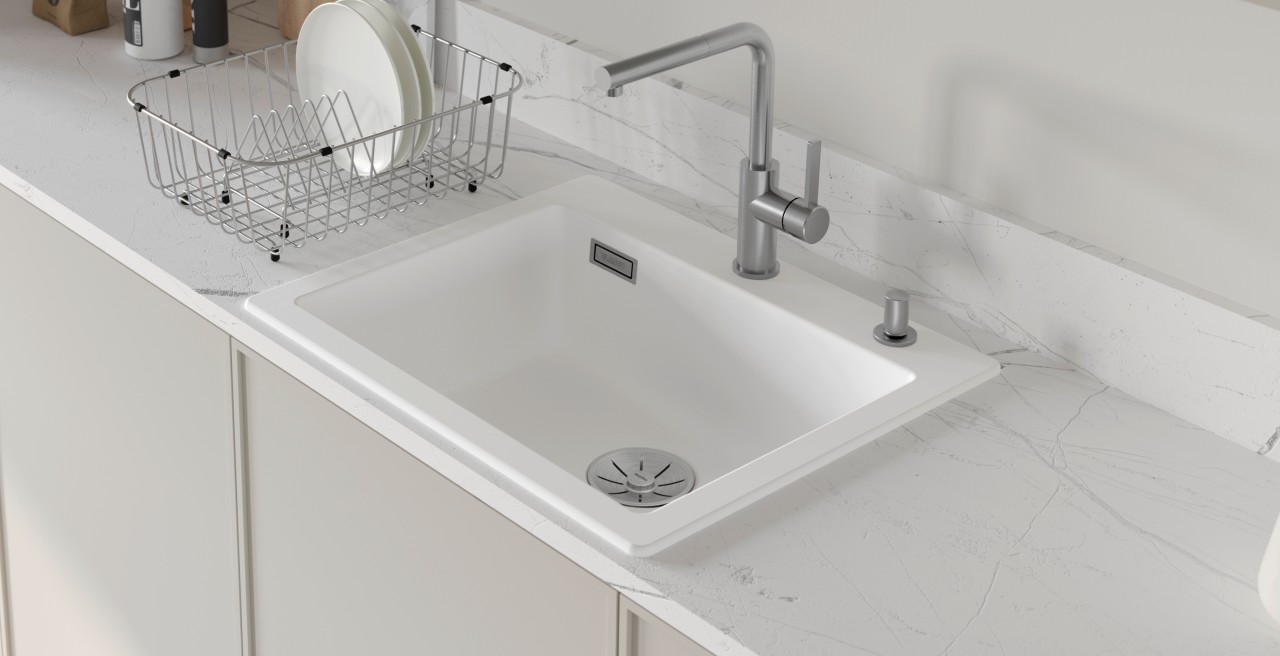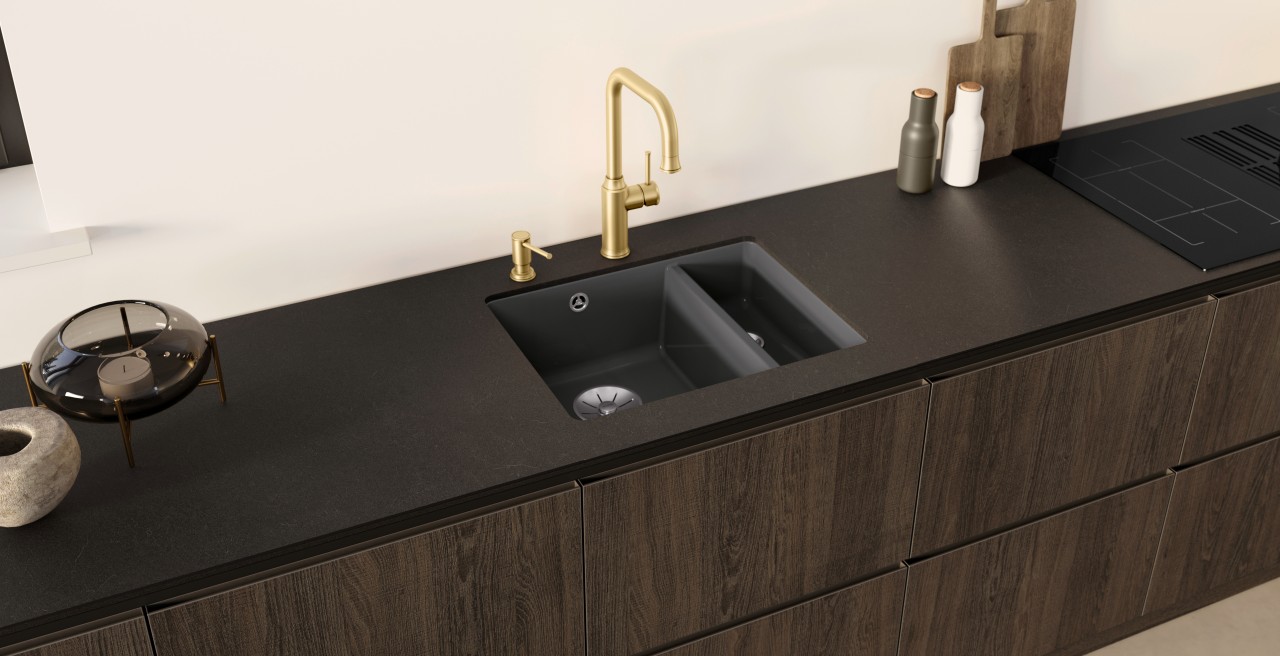Cleaning ceramic sinks: how to look after ceramic surfaces
Ceramic sinks are rightly considered to be easy to clean. They have a smooth, hard and completely sealed surface. This prevents dirt and liquid from getting into the material. However, there are a few things to be aware of when cleaning ceramic. In order to ensure that you ceramic sink remains beautiful and easy to maintain for a long time to come, we recommend three levels of care – daily cleaning, monthly deep cleaning and surface freshening-up – and provide advice on suitable cleaning products to use. This way, you’ll be able to enjoy your BLANCO Ceramic sink for many years yet!
What makes ceramic sinks special
Ceramic is a highly resistant material. It is resistant to heat and cold, as well as being shock- and scratch-proof. Bacteria have no chance against the smoothness of ceramic sink surfaces. Liquids such as water and oil run off it very easily, so that hardly any marks can form. These properties mean that ceramic sinks always look very clean and well cared for. Their soft feel also makes day-to-day work with ceramic sinks a real pleasure.
Impressive ceramic sinks
Daily cleaning
Cleaning ceramic sinks is extremely easy: as the material is very dense, hardly any marks can form, as dirt simply cannot adhere to it. However, you should still give your ceramic sink a quick clean every day. All you need is a standard sponge, a little washing-up liquid and water. Slightly moisten the sponge under running water. Squeeze a small amount of detergent onto the soft side of the sponge. Clean dirt off your ceramic sink by rubbing the soft sponge over the surface in small, circular movements. Finally, rub the surface dry with a microfibre cloth. As you can see, ceramic is very easy to look after!
Monthly deep-cleaning
In order to conquer particularly stubborn limescale deposits, we recommend using BLANCO CeraCare, a biological cleaner specially designed for ceramic surfaces. You should do this kind of deep clean every 3 to 4 weeks.
Using it is easy: Dip the enclosed sponge lightly into the open CeraCare can. Clean your ceramic sink with small, circular movements. After applying the CeraCare, leave it to work for a few minutes before rinsing with clean water. This is particularly easy to do if you have a pull-out spray.
Freshening up surfaces



If your BLANCO Ceramic sink has a PuraPlus surface, you should freshen it up at regular intervals. PuraPlus is a hydrophobic special coating from BLANCO. It reduces the adhesion of limescale, making daily cleaning easier. To maintain this effect, we recommend the BLANCO PuraPlus set, a two-component care product especially designed for PuraPlus ceramic surfaces.
Apply a little PuraPlus starter to a microfibre cloth and rub it evenly into the sink, working in small, circular movements. Now dry the surface thoroughly.
For the second step, use the PuraPlus liquid. Shake the bottle briefly, then pour some PuraPlus liquid onto a paper towel. Rub it into the sink in small, circular movements. Now leave it to work for approx. 10–15 minutes. Finally, polish the surface dry with a microfibre cloth until there are no streaks left.
After treating the sink with PuraPlus liquid, you’ll notice how the water rolls straight off it: liquid no longer clings to the surface, causing less limescale.
Avoid these cleaning agents
Although ceramic surfaces are impervious to marks, you should be aware of the following: Certain cleaning agents should not be used to clean ceramic. These include:
- Scouring agents or powder
- Aggressive, highly concentrated drain cleaners
- Strong mixer tap and steel cleaners
- Prickly brushes or steel sponges
All of the aforementioned things can cause damage to the surface. This causes the sink to lose its shine and appear matt. In order to avoid this, we recommend using BLANCO cleaning and care products, which are designed for the precise properties of ceramic.
Questions about ceramic sinks
They are the ultimate synthesis of nature and design, as we make our ceramic sinks from natural raw materials. This means that every sink is a unique piece – including yours. This is apparent from the look and feel every time you come into contact with it. Delicate forms, tasteful accents and full-bodied colours charm not only the eye, but also bring magic to the heart of your kitchen.
Above all, this is down to the expertise and care taken by our employees. They always create sinks that meet the highest standards, with patience and precision. The natural character of ceramic sinks gives them certain tolerances that we observe and check meticulously. We voluntarily submit our ceramic sinks for regular testing by the Certification Board of the Bavarian State Testing Authority (Landesgewerbeanstalt Bayern, LGA). These always come back with the same result: confirmation that you can rely unconditionally on our ceramic sinks.
Cutting, chopping and heat: things can really hot up in your kitchen. And that’s precisely when your ceramic sink shows just what it can do. Its high-quality workmanship allows it to rise to any challenge, thanks to its hard and robust surface, which makes your sink scratch- and cut-resistant. What’s more, it is shock-resistant.
However, you shouldn’t take that as an invitation to treat it roughly. Exceptionally large and heavy objects should not be dropped onto its surface from a height. This would leave a mark on even this robust sink.
When vegetables, meat and fruit have all done their worst on the ceramic sink, you’d expect to be faced with something of a disaster. But you don’t need to worry about all that with your ceramic sink. The smooth and completely unbroken surface ensures that no dirt can settle on it. What’s more, any soiling that is visible after long cooking sessions is easy to tackle. Just get a soft sponge, a little washing-up liquid and warm water, and wipe it away. A microfibre cloth is best for rubbing it dry. However, steer clear of scouring agents, steel brushes and aggressive mixer tap cleaners containing chlorine. Your ceramic sink won’t like these at all.
You won’t want to do things by halves when it comes to cleaning your house. If you want to get your space spotlessly clean, from your living room to your kitchen, then you're going to use using cleaning agents – standard household cleaners, alkaline and acid solutions. Your ceramic sink is fairly forgiving. If acids or alkalis accidentally find their way into the sink, you can simply carry on with your cleaning. After all, our sinks are resistant to these substances.
If you have ever needed to take a boiling hot pot of pasta off the stove, you’re bound to have asked yourself, “Now, where can I put this?” Your ceramic sink provides plenty of space for such eventualities. After all, it is outstandingly heat-resistant, so high temperatures cannot damage it. As such, you won’t have to worry about discolouration or bleaching. Sizzling pans and hot pots at up to 280 °C can simply be taken off the stove and placed directly in the sink.
Not only are our ceramic sinks ideal for day-to-day washing up, but they also provide a space to chop up tomatoes, meat and garlic. The material makes it ideal as a place for food. The smooth, non-porous surface prevents food remains from getting stuck.
Light soiling caused by cutting, frying or cooking on nearby utensils is easily remedied. It can be eliminated even faster than it appeared with a soft sponge, a little washing-up liquid and warm water. This means no unpleasant smells or unsightly discolouration on your sink.
Our ceramic sinks are non-fade. This means that you can install your sink in a bright room or in front of a window. Direct sunlight doesn’t pose any problem, so the colour of your sink will stay just as it was when you got it, for years to come. By the same token, standard household use of your sink will not alter its colour.
If your sink sees a lot of use, light limescale deposits may form over time. When combined with foodstuffs like coffee or red wine, this can cause slight discolouration. But there’s no need to panic: you can address the problem in a matter of minutes. In this case, use vinegar concentrate or a professional biological cleaner such as our BLANCO Antikalk. Soon you’ll see that you were worrying about nothing.
PuraPlus is a special coating designed for our ceramic sinks. Not only does it have a great name, but it also makes life in the kitchen that much easier. The sealing effect gives your sink a fine-pored, unbroken surface that causes water to simply roll off it. This protects it against limescale deposits, while impurities hardly stand a chance of settling there. As far as you are concerned, this means a sink that you can clean in just a few steps every day.
If time-consuming cleaning marathons really aren’t your thing, rest easy: your ceramic sink is very low-maintenance. Just putting some warm water and washing-up liquid on a soft sponge and cleaning your kitchen sink with it every day will do the trick. Limescale is best avoided by rubbing your sink dry with a microfibre cloth afterwards.
If you find stubborn dirt on your otherwise spotlessly clean sink, it’s best to opt for a professional cleaning agent. BLANCO PuraPlus Liquid goes a good job of pre-cleaning worktops that require extra effort. This cleaner removes limescale deposits and metal abrasion, without being too taxing. Fast and straightforward In order to ensure that water continues to roll off your sink, it’s worth using a care product like BLANCO CeraCare, which both cleans and nourishes the surface. This will re-seal the surface of your sink. Avoid scouring agents, aggressive drain cleaners and scratchy brushes or steel sponges. These will damage the pristine surfaces. What’s more, they could cause the sink to lose its lovely shine.
The basket strainer is the secret hero in your sink. After all, it prevents your sink from getting clogged up, thus ensuring perfect functionality. Over time, however, the basket strainer will collect some dirt, so you should give it a clean every now and then. You don’t even have to buy a special cleaner for that purpose.
Here’s our trick: put a level teaspoon of powdered dishwashing detergent onto the closed basket strainer. Pour approx. 250 ml boiling water over it and leave the solution to work. Now brush and scrub it (e.g. with a dishwashing brush) until the basket strainer and drain cup are shining once again. Finally, open up the basket strainer and take out the basket insert. Now you have room to clean the hole opening in the drain cup. Once this is squeaky clean too, reinsert the basket insert and rinse it with clean water.
We do our bit to make sure that you’re all set up, so almost all our stainless steel and ceramic sinks come with a punched-out tap hole. This means that you won’t have to do any extra work before installing it. Some Silgranit sinks are milled from the underside. You simply have to knock through the pre-milled holes.
How to do it: first place the sink in a sturdy holder. Now take a punch and place it in the middle of the mark. Use a hammer to hit the punch holes for the mixer tap, soap dispenser and drain remote control, as required, without exerting force on the punch itself. Then carefully knock the rest of the Silgranit pieces out of their marked holes. Now get a file and file the hole to the right size. You may need to do this if the hole is flush with the preliminary milling. Now there’s only one thing left to do: insert your mixer tap, and off you go.
Milky patches can soon show up on your stylish dark sink. These are caused by limescale deposits, which can vary hugely from place to place, and depending on the state of your water pipes. Such stains also pick up deposits from substances like tea or coffee, and are thus responsible for discolouration. But all this isn’t as bad as it sounds. Luckily, BLANCO Antikalk, a little vinegar-based cleaner or diluted citric acid and hot water can come to your rescue. The limescale will dissolve if you clean your kitchen sink thoroughly with these substances.
If you don’t want to constantly have to contend with unsightly marks, be sure to dry your sink off with a microfibre cloth after every use. Doing this will prevent the limescale from occurring in the first place.


